If you have a brick-and-mortar store, but your retail business needs an expansion, your next strategy should be to reach a broader audience through an online store. An online store gives you the opportunity to engage with local and foreign customers in today’s technologically savvy world, expanding the reach of your company internationally.
Ecommerce is growing at lightning speed. eMarketer expects global ecommerce sales worth $6.151 trillion in 2023.
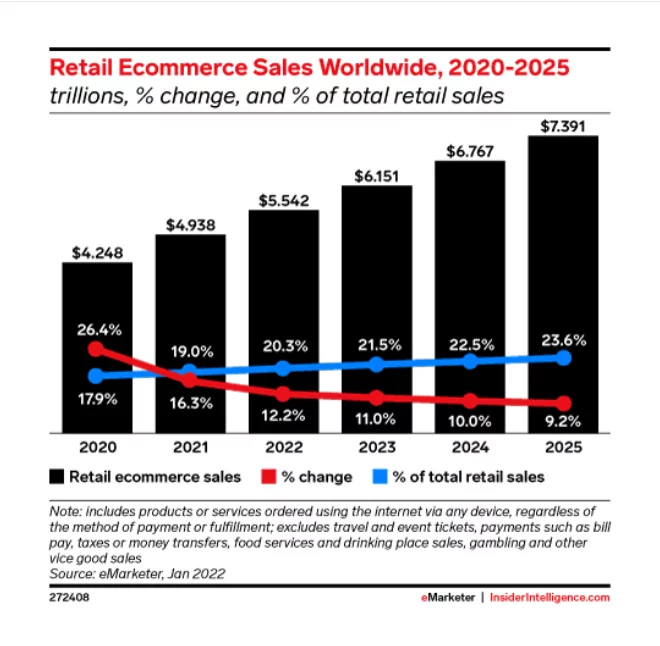
Choosing the best opensource ecommerce platform is one of the most crucial choices you will make if you want to launch an online store to take advantage of the above global market development. The best option among the various e-commerce options relies on your requirements.
Platforms for Opensource Ecommerce: What to Consider
It is more challenging to choose an ecommerce platform than to decide what to eat for lunch. You must take into account your staff’s skills, your organization’s potential expansion, the convenience of use for both the front and back end, and, of course, the cost.
Ask some questions to yourself before selecting a platform:
- Usability: Is the platform’s user interface simple to use? Does it require a lot of time to learn how to use it?
- Scalability: Ideally, you should use an ecommerce platform that expands together with your company. Does the potential solution help both small and large businesses?
- Autonomy: Are you in complete control of the platform, or are you dependent on a provider? Like social media platforms, SaaS ecommerce systems, for instance, undergo continuous modifications, and you must adapt to the changes in order to maintain your business.
- Protection and upkeep: Think about upkeep and safety. Do you possess the technological know-how to handle things on your own? Do you have the funds to employ someone to complete it for you? Or would you rather that the platform’s experts take care of the maintenance and security for you?
- Cost: Are the platform’s goals within your short- and long-term spending limits? For instance, SaaS solutions simplify running an online store, but costs could increase considerably if your online store expands.
- Support: Are you able to resolve any software issues you may have? Or would you require platform customer support?
- Customization and features: Does the platform offer the features you want? Can it be customized? Will you be content to use the platform’s built-in capabilities if you are obligated to use it, or do you want access to third-party tools? Look for an ecommerce solution that is easily adaptable and accessible to connectors if you wish to employ third-party solutions.
Best Opensource Ecommerce Platforms for 2023
-
WooCommerce
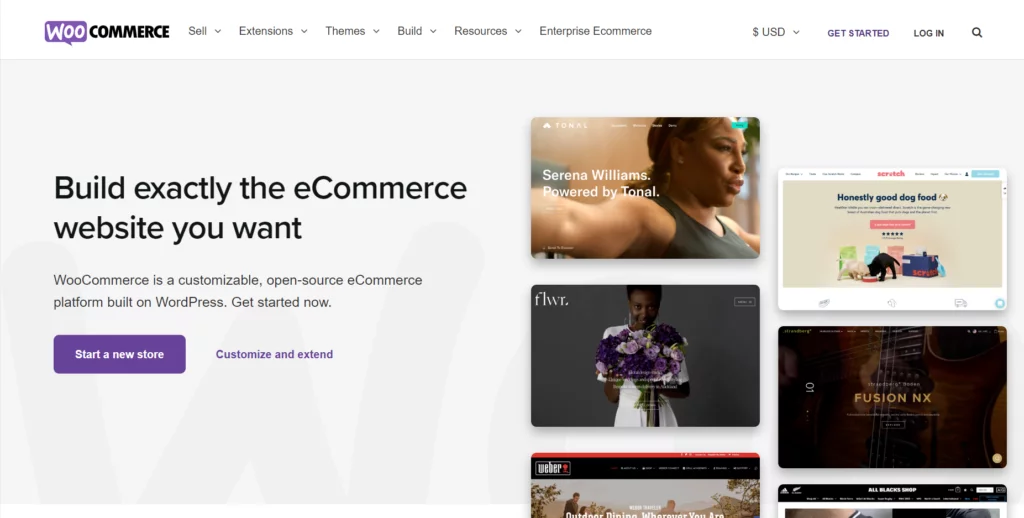
WooCommerce is a well-known e-commerce plugin that adds e-commerce features to the WordPress content management system (CMS), including inventory control. More than 5 million e-commerce websites are run by it. The top 1 million ecommerce websites primarily use WooCommerce and Shopify, with WooCommerce holding a 29% market share (compared to Shopify’s 21%).
WooCommerce can be used for free; however, WordPress hosting is necessary. The WooCommerce-specific capabilities of Nestify’s hosting are available to you. WooCommerce is surprisingly simple to use and is speed-optimized, in contrast, to opensource ecommerce platforms that frequently demand technical skills.
Pros
- Wide range of both free and premium WooCommerce themes that are flexible and adaptable, like WordPress
- Vast collection of extensions
- Integrated security measures
- Support for multiple integrations
- Extremely scalable
- Store builder using drag and drop
- For users to create a successful store, HTML and CSS are not required.
Cons
- As the store scales, you could require technical assistance.
- Although you can not receive native hosting services, this problem can be fixed by using Nestify optimized Woocommerce hosting.
Pricing: Free
-
Magento
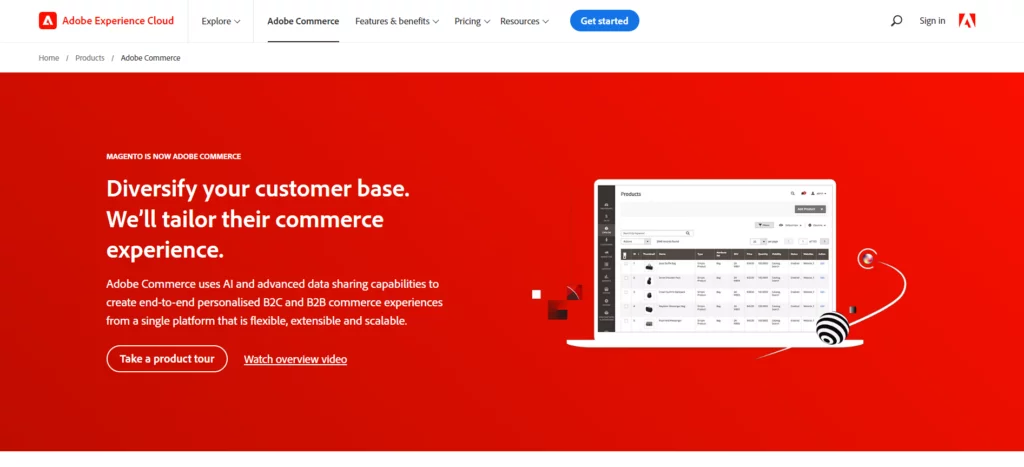
Opensource ecommerce software called Adobe Commerce (formerly known as Magento) is a feature of the Adobe Experience Cloud.
More than 250,000 enterprise-scale online retailers utilize Adobe Commerce, a robust, adaptable, scalable, and customizable opensource platform, to manage numerous products and high traffic. As an illustration, HP, previously Hewlett-Packard, also makes use of Adobe Commerce. Because Adobe Commerce was created from the developer-focused Magento platform, it calls for highly specialized technical knowledge.
Pros
- 24×7 client service
- API interfaces
- Extensions offered with the Magento store
- Provides cutting-edge SEO tools and services that can help with store ranking
- Integrated analytics
Cons
- Costs a lot of money to open the store
- It takes some time to set up a Magento store
- Ineffective hosting options may limit the store’s capacity to grow.
Pricing: Magento Opensource is available for free. Check out the custom pricing for advanced features. Also, Adobe’s pricing is available on request.
-
Drupal Commerce
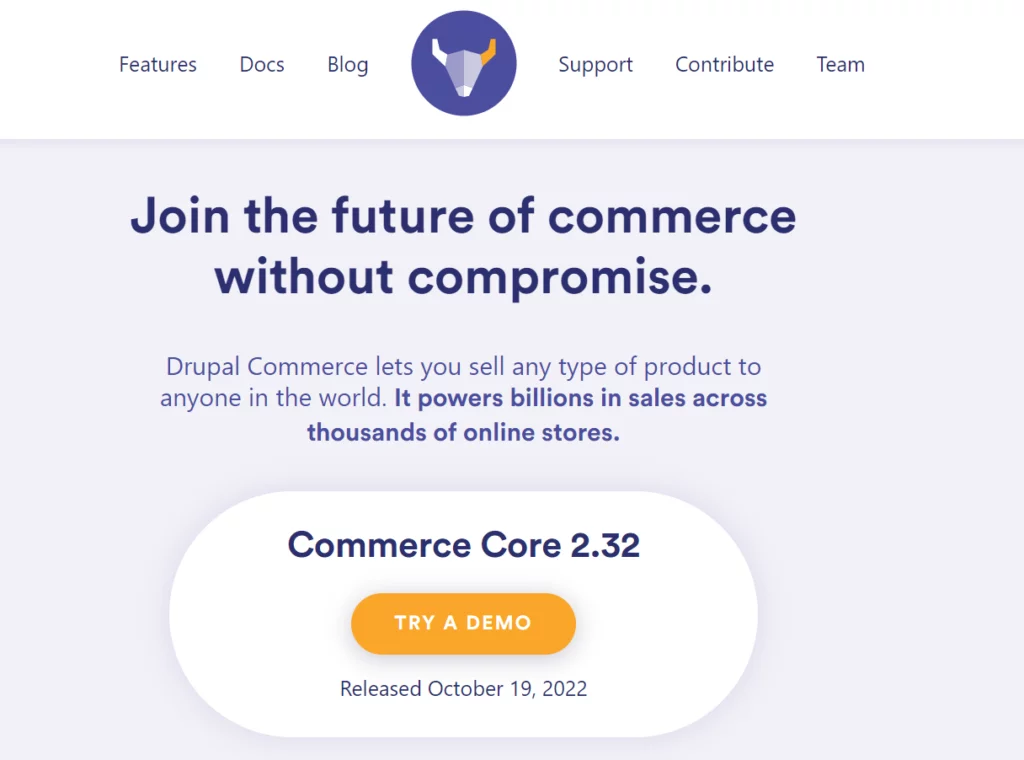
Drupal Commerce is an e-commerce platform created on the opensource Drupal CMS, which is comparable to WordPress.
There needs to be more than opensource ecommerce platforms because Google’s algorithms have changed to favor and value content marketing. If you want to rank for content, your ecommerce platform needs to have a good CMS capability. This is a feature that Drupal Commerce provides.
Commercial websites like Cartier frequently use Drupal Commerce.
Pros
- SEO and marketing tools for increasing online presence
- Tools for managing orders
- Analytics and Reporting
- RESTful API integration with other systems
- Drupal has a sizable, active community, making it simple to address typical shop issues.
Cons
- It is not appropriate for complete beginners.
- Without a managed hosting platform like Nestify, managing a Drupal site can be difficult.
Pricing: Free
-
Joomla

The second-most popular opensource CMS, Joomla was introduced in 2005. It has more than 200,000 users in its community and powers 2.5% of all websites. By implementing an extension, Joomla may be used for online shopping just like WordPress.
Since Joomla is an opensource ecommerce CMS, you have the freedom to customize the online store as you see fit. For each web page, you can use a separate template. However, it takes the same deep technical knowledge as Adobe Commerce. Brands like IKEA, Lipton, and Holiday Inn prefer Joomla.
Pros
- The marketplace offers more than 6,000 addons to increase functionality
- Receptive design Products abound
- Support for several languages and currencies
- It is highly adaptable, and your Joomla stores can even support the sale of digital goods.
- Extremely simple to use and edit
Cons
- Some helpful plugins are incompatible with beginners.
- You might occasionally need to use premium plugins.
- Only Joomla hosting that has been optimized will function best for your store. Shared hosting and ineffective hosting options can harm the store.
Pricing: Free
-
OpenCart
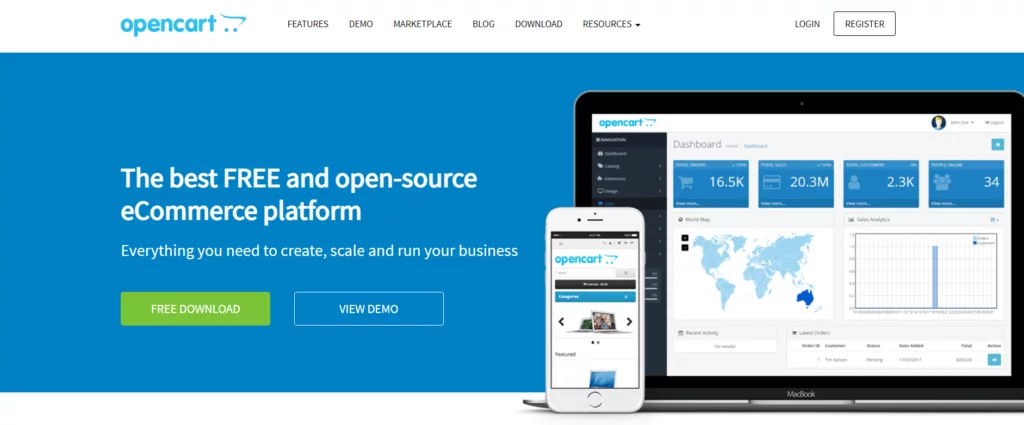
Over 400,000 website owners use the open source OpenCart ecommerce platform, including Red Cross UK. It has several features, including the ability to manage multiple stores from a single interface and a marketplace with a wide variety of themes and extensions.
OpenCart, however, only provides a small amount of SEO and marketing capability, which may prevent you from expanding your e-commerce site. Additionally, since OpenCart does not offer customer assistance, using it would require technical expertise.
Pros
- The admin dashboard includes a feature overview.
- Tools for backup and recovery
- Large marketplace with more than 13,000 extensions and addons
- assistance with discount coupons and abandoned shopping carts
- cellular compatibility
Cons
- fewer available payment gateways
- It can be difficult to optimize the store for search engines. There are not many trustworthy SEO tools that work with OpenCart.
Pricing: Free
-
PrestaShop

PrestaShop is an opensource ecommerce platform constructed on the Symfony framework, which increases flexibility by enabling you to choose and include the modules you require on your website or application.
PrestaShop includes more than 5000 modules and over 600 functionalities, but many of these extras have a price. Additionally, if you lack technical expertise, PrestaShop provides a fully managed service that combines hosting and maintenance with their opensource software.
PrestaShop is used by more than 300,000 online stores, including Zippo Lighters and Fashion Stork. It requires that you utilize its internal solutions because it does not support a number of widely used integrations.
Pros
- There are several modules and addons for greater functionality.
- 3000+ mobile-friendly template options
- tools that combine SEO and marketing
- multi-currency support
Cons
- Limited assistance is available
- In the future, scaling the store might provide a problem.
Pricing: Free; managed solution plans start at €450 ($473) per month.
-
Bagisto
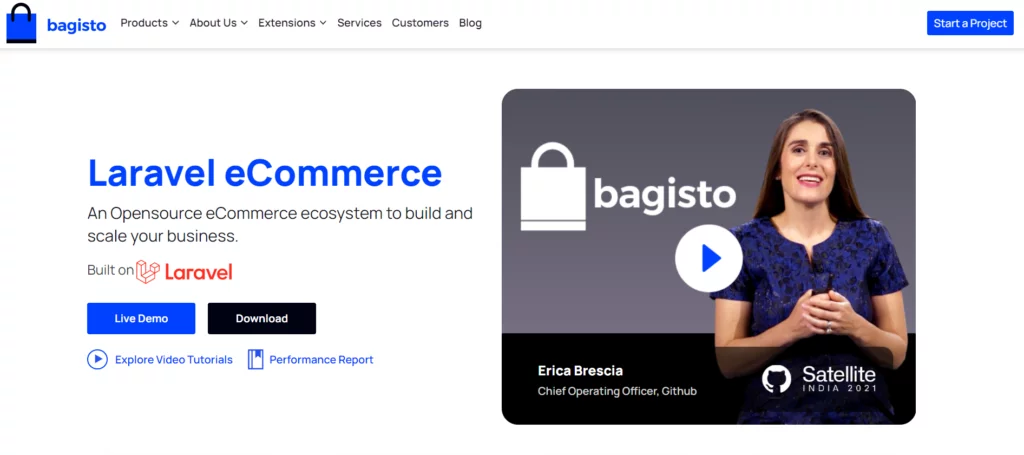
The opensource Laravel PHP framework powers Bagisto, an ecommerce platform. This platform provides a wide range of fundamental to sophisticated ecommerce-enabling capabilities, making it a top choice for new businesses and small- to medium-sized business owners.
You can create a multi-vendor marketplace with Bagisto that includes RTL support and strong SEO features. Additionally, you can link your business to numerous inventory sources, manage multi-channel inventories from a single website, and conveniently keep track of your product stock levels at any given time.
Pros
- There are numerous customizing choices.
- Suitable for people who want to stay away from difficult coding and framework versions
- A platform that is open-source and has a sizable and active community
Cons
- In comparison to Woocommerce, the community is smaller
- Finding answers to issues can occasionally prove difficult
- For new users, installing new modules can be tricky
Pricing: Starting from $39.00/Per-Month
-
CubeCart

The 2003-founded British opensource ecommerce platform CubeCart is becoming more and more well-known both inside and outside of the UK. With the help of an adaptable skin powered by templates and CubeCart, online shops are visually appealing on a variety of devices. However, because it lacks functionality, it is unsuited for corporations and its flexibility is restricted to how an online store appears on different devices. It also is not as extensible as OpenCart, despite the fact that it integrates with several applications.
Although it released all of its software for free in 2015, CubeCart also provides hosted and self-hosted versions of its program. Harris Organic Wines and Kula Cards are two CubeCart supporters.
Although CubeCart is an opensource ecommerce platform, it does not offer live customer support. However, you can purchase technical support for a small monthly fee.
Pros
- Zero-cost pricing strategy
- Large features are necessary for online selling
- Easy-to-use controls and interface
- Customizable addons and themes
Cons
- Lack of phone support for CubeCart
- The platform can only be significantly modified with coding knowledge.
- Users are in charge of the security and upkeep of the self-hosted versions
Pricing: Free with no customer support. Paid plans start at $33 per month.
-
Shopware

German opensource ecommerce platform Shopware was established in 2000. Shopware was created using Vue.js for the front end and Symfony for the backend. With more than 100,000 users globally, including companies like Aston Martin and M&Ms, it has a sizable developer community.
4,000+ extensions, fully integrated CMS capabilities (similar to Drupal), and integrated SEO and marketing tools are just a few of the notable Shopware features.
Pros
- Comprehensive CMS capabilities
- Drag-and-drop interface for simple online store customization
- Specialized tools for SEO and marketing
- Google Shopping and social network integration
- Options include self-hosting and cloud-hosting
Cons
- Unusually high costs
- Fewer than average number of plugins
- A higher price for using social media
Pricing: Free with limited features. Premium plans start at €199 ($210) per month.
-
Wix

One of the most well-known cloud-based online store builders is, without a doubt Wix. Wix offers an option for you to create a stunning free website, even though its bulk packages are more expensive.
The finest feature of this particular platform is that even free users may utilize its user-friendly drag-and-drop website builder to create a whole website without any coding knowledge. In actuality, it should only take you a few minutes to finish a simple free website.
For novices who require powerful tools for creating and hosting a typical business website, the free plan is especially suitable. It provides access to a large selection of readily adaptable predesigned templates along with extra icons, clip art, and photos.
Additionally, you can advertise your free business website using Wix’s basic SEO and email marketing features, which are both provided without cost. This may be combined with a variety of other free Wix App Market applications to create a dynamic marketing framework.
Pros
- Its drag-and-drop website builder is basic. Design and personalize a free website without coding.
- Online store features are worth the cost. Ecommerce site features cost at least $16.50.
- Wix has several attractive site themes and designs.
- Professionally built for responsiveness and mobile optimization.
- If you wish to add features to your premium site, use the huge Wix App Market. This offers abandoned cart recovery, payment processors, global shipping providers, and more.
- Wix does not take a percentage of your online sales from your ecommerce website. Payment processors subtract transaction fees.
Cons
- Free ecommerce websites cannot be completely provided. Selling requires at least the $16.50 eCommerce bundle.
- Ads in the free plan may alter your site’s look. Websites will appear cluttered.
- Wix hides its code. You cannot personalize your website extensively. Themes and templates limit you.
- You cannot switch website themes midway through editing. You have to start anew.
Pricing:
The ecommerce store costs $16.50/month
Premium plans start at $4.50/month
VIP plan is $24.50/month
Conclusion
One of the most crucial choices you will make as an ecommerce business owner is selecting an ecommerce platform. Opensource ecommerce platforms like WooCommerce provide the freedom you need to scale and improve customer experience. WooCommerce might be helpful if you are beginning or managing a small to medium-sized business. On the other hand, you might profit from Magento’s features if you are setting up an online storefront for a corporate business. Consider your products, technological know-how, and business size while considering your possibilities. In other words, evaluate how much customization, functionality, and scalability you require.
Which opensource ecommerce platform do you prefer? Please tell us in the comments.



